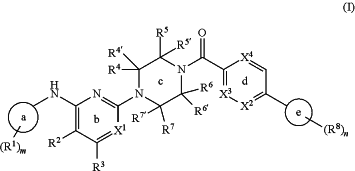| CPC C07D 401/14 (2013.01) [C07D 403/14 (2013.01); C07D 487/08 (2013.01); C07D 498/08 (2013.01)] | 14 Claims |
|
1. A compound represented by formula (I), or a stereoisomer or tautomer thereof, or a pharmaceutically acceptable salt thereof:
 wherein
ring a is selected from pyrazolyl, pyridyl and pyridonyl;
R1 is selected from hydrogen, C1-C3 alkyl, and C3-C6 cycloalkyl, wherein the C1-C3 alkyl and C3-C6 cycloalkyl are optionally further substituted with one or more halogen atoms;
X1 is selected from CH and N;
R2 is selected from hydrogen and C1-C6 alkyl;
R3 is selected from hydrogen, cyano, C1-C6 alkyl, C1-C5 primary alcohol group, C3-C7 tertiary alcohol group, C1-C3 alkoxy, C3-C6 cycloalkyl, and —R9CO2R10, wherein the C1-C6 alkyl, C1-C5 primary alcohol group, C3-C7 tertiary alcohol group, C1-C3 alkoxy, and C3-C6 cycloalkyl are optionally further substituted with one or more halogen atoms;
alternatively, R2, R3 and the two carbon atoms attached thereto together form an aryl group, and the aryl group is optionally further substituted with one or more halogen atoms or C1-C6 alkyl;
R9 is selected from a chemical bond and C1-C4 alkylene group;
R10 is selected from hydrogen and C1-C6 alkyl;
X2, X3, and X4 are selected from CH and N; when X2 is N, at most one of X3 and X4 is N; when X2 is CH, X3 and X4 are both CH;
R4, R4′, R5, R5′, R6, R6′, R7, and R7′ are independently selected from hydrogen, C1-C3 alkyl and C1-C4 alkoxy, wherein the C1-C3 alkyl is optionally further substituted with one or more hydroxy, carboxy or cyano groups;
alternatively, R4 and R4′, R5 and R5′, R6 and R6′, or R7 and R7′ are attached together to form —(CH2)2—, —(CH2)3—, —CH(CH3)CH2—, —OCH2CH2—, or —CH2OCH2—;
alternatively, R4 and R5, R4 and R6, R4 and R7, R4′ and R5′, R4′ and R6′, R4′ and R7′, R5 and R6, R5 and R7, R5′ and R6′, R5′ and R7′, R6 and R7 or R6′ and R7′ are attached together to form —(CH2)q— or —(CH2OCH2)—;
alternatively, R4 and R4′, R5 and R5′, R6 and R6′, or R7 and R7′ together represent ═O;
ring e is selected from pyrazolyl, pyridyl, phenyl and 3-azabicyclo[3.1.0]hexane-3-yl;
R8 is independently selected from hydrogen, halogen, cyano, C1-C3 alkyl, C1-C3 alkoxy, and C3-C6 cycloalkyl, wherein the C1-C3 alkyl, C1-C3 alkoxy, and C3-C6 cycloalkyl are optionally further substituted with one or more halogen atoms;
m is 1 or 2;
n is 1, 2 or 3; and
q is 2 or 3.
|